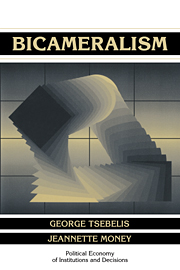Book contents
- Frontmatter
- Contents
- List of tables and figures
- Series editors' preface
- Acknowledgments
- Introduction
- PART I THE HISTORY AND GEOGRAPHY OF BICAMERAL DIVERSITY
- PART II MODELS OF BICAMERAL INSTITUTIONS
- PART III EMPIRICAL STUDIES OF BICAMERALISM AND IMPLICATIONS
- Introduction to Part III
- 6 The outcomes of intercameral bargaining
- 7 The process of intercameral bargaining
- 8 Conference committees
- 9 Implications
- Conclusions
- References
- Index
Introduction to Part III
Published online by Cambridge University Press: 02 December 2009
- Frontmatter
- Contents
- List of tables and figures
- Series editors' preface
- Acknowledgments
- Introduction
- PART I THE HISTORY AND GEOGRAPHY OF BICAMERAL DIVERSITY
- PART II MODELS OF BICAMERAL INSTITUTIONS
- PART III EMPIRICAL STUDIES OF BICAMERALISM AND IMPLICATIONS
- Introduction to Part III
- 6 The outcomes of intercameral bargaining
- 7 The process of intercameral bargaining
- 8 Conference committees
- 9 Implications
- Conclusions
- References
- Index
Summary
In the next four chapters we empirically investigate the predictions developed in Part II and compare our findings with alternative theories of bicameralism outlined in Chapter 1. In Chapters 6 and 7, we draw on data from the French Fifth Republic. The prominent position of France is attributable to the complexity of its institutions: the two houses may be equal or, upon decision of the government, unequal; the deliberation may involve a conference committee or not; the navette may conclude after a single round or last indefinitely. With the exception of the United States and the European Union, no other country or institution has bicameral procedures that vary so extensively. Thus, France presents an opportunity to test various dimensions of our models and to evaluate institutional features of the bicameral systems described in Chapter 2 within a single country, so that we can hold a variety of conditions constant.
Chapter 8 relies more heavily on data from other countries in order to capture the variations in conference committee composition, decisionmaking rules, and constraints imposed by the parent chambers – the characteristics of conference committees that are important independent variables in our theoretical models. The tests presented here are far from exhaustive. We strongly believe our models should undergo additional evaluation employing data from a wide variety of countries. Nonetheless, the evidence presented here helps to establish the plausibility of the models developed in Part II.
In Part III, we employ both statistical analysis and case studies to evaluate our theoretical arguments. Undoubtedly, it would be helpful to extend statistical analyses further than we have done in this book.
- Type
- Chapter
- Information
- Bicameralism , pp. 125 - 126Publisher: Cambridge University PressPrint publication year: 1997



